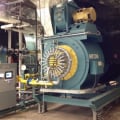Welcome! Here are the website rules, as well as some tips for using this forum.
Need to contact us? Visit https://heatinghelp.com/contact-us/.
Click here to Find a Contractor in your area.
If our community has helped you, please consider making a contribution to support this website. Thanks!
Need help with DHW load calculation
Options

Mike_Sheppard
Member Posts: 698
I have an estimation of 1,500,000 btu/hr DHW load at peak hours.
How do I convert that to required gallons per hour?
How do I convert that to required gallons per hour?
Never stop learning.
0
Comments
-
1,500,000/60= 25,000 but/min. Then you have to know what water temp you start at and end at.
say 50 degrees start and 140 end=90 degree rise
water is 8.33lbs/gallon
takes 1 btu to raise 1 lb of water 1 degree
so btus/temp rise =lbs of water
lbs of water/8.33=gpm
So 25,000btu/90=277lbs/ min
277/8.33=33 gpm
33gpm x 60=1980 gph
Keep in mind that for a storage tank 80% of the water is considered useable the remaining 20% is diluted by the incoming cold water.
Also the btus are net. You have to find your input base d on the efficiency of the equipment say 20%0 -
@EBEBRATT-Ed thanks man, I really appreciate it! I was sitting down trying to do this and it just wasn’t coming out right. I was forgetting the first step...dividing by 60 to get btu/m.
Could you help me taking the storage in to account?
So currently they have two 3 million btu condensing boilers dedicated to providing hot water. They are running at 180 degrees and circulating through four plate and frame heat exchangers to make hot water. The pumps are providing about 1/4 of the GPM needed to support 6 million btus.
I’ve observed operation for several mornings now during peak load. One boiler running at 46% is the highest I’ve ever seen it run. So we’re looking at somewhere around 1,500,000 btu/hr peak load.
They have 600 gallons of storage (three 200 gallon tanks).
The building has 341 apartments. Even at one bath per apartment we come out higher than 2000gph load. Around 2710 gph. And that’s not including washing machines. One bath is the minimum in this building, they go up to 3 bath apartments. They are currently getting me a full list so I can get a more accurate number.
But I’m not sure how to go about sizing new water heaters. 6 million is obviously way too much. But they maintain load no problem at 1.5 million btus which is way smaller than what a sizing calculator spits out.
How would you go about this?Never stop learning.0 -
@Mike_Sheppard are you keeping the HXs, tanks and boilers? what are you going to replace?0
-
@EBEBRATT-Ed storage tanks yes, they’re brand new. The heat exchangers need to go.
I’d like to use the Bradford White eF series or Laars UHE water heaters but this application might be too large. Outside of that I haven’t thought much yet of which water heater or boiler/HX combo to put back in.Never stop learning.0 -
How about this way? The hours inherent in the 500 constant would cancel out the hours in the 1500000 btu and thus the remaining measurement is a minute measurement . (GP M)
At 1,500,000 btu/hr.
90f delta x 500 = 45000
Gpm = 1500000 ÷ (500 x 90 delta) = 33.330 -
Size the hX large enough and you could generate DHW with condensing temperatures and best leverage high efficiency operation. With close approach sizing you should be able to get DHW within 5° maybe 3 of boiler SWT.Mike_Sheppard said:@EBEBRATT-Ed storage tanks yes, they’re brand new. The heat exchangers need to go.
I’d like to use the Bradford White eF series or Laars UHE water heaters but this application might be too large. Outside of that I haven’t thought much yet of which water heater or boiler/HX combo to put back in.
Idronics 6 has a manual formula for sizing HX. All the HX brands seem to have free simulators at their website for quick sizing and "what if" options.
Bob "hot rod" Rohr
trainer for Caleffi NA
Living the hydronic dream1 -
I plugged the project into Pro-Size from A.O. Smith. One 3 million BTU boiler is sufficient with 121% of demand and 600 gallons of storage. If your are planning on using a flat plate heat exchanger, you need to use a 10% fudge factor due to fowling. Your heat exchanger needs to be 3,300,000 BTU capacity. Taco, Armstrong and others can figure it out for you can figure it out for you. Dont get fooled by the kid desk jockey that asks for 40 to 140F. It won't work. It is 120F to 140F on the cold side at 3,300,000 BTU.
This program has never failed me on any apartment, condo or hotel.
Here are the results.

0 -
BTW the A.O. Smith boilers are Lochinvar. This combination will condense.0
-
Important item.
How are the three tanks piped.
Te piping configuration is important because the storage tanks allow you to use a smaller plate and frame heat exchanger.
What is important is the building recirculating line needs a properly sized circulating pump to circulate water from the hot water return line.
Assume you want water at 120 degrees out the circ pumps aquastat should be set at 110f.
The recirc line needs to be piped to the cw inlet of the three tanks with a check valve to prevent HW from backing into the cw supply.
Remember hot water is at a greater pressure than cw. The reason or that is heated water expands in volume therefore the pressure increases slightly.
Before replacing anything check the piping configuration of the tanks.
Make sure you have a circ pump on the return.
In a lot of old buildings the returns were by gravity not pumped.
See A.O.Smiths piping configuration, it basically has your three tanks operating as one storage tank.
Jake
Steam: The Perfect Fluid for Heating and Some of the Problems
by Jacob (Jake) Myron0 -
@Henry Thank you for the info. I was getting about the same result. I know once I get the full apartment bath count it will be more than one bathroom per apartment. They have apartments up to 3 bathrooms here. But currently in the middle of winter with the coldest incoming water temp (about 40 degrees) they’re not even using 1,500,000 btus at full demand. I don’t know if what I plug into these calculators should be believed or not. If they are overestimating.Never stop learning.0
-
I’d like to see what you guys come up with for this one.
37 unit apartment building
Each has 2 baths, 2 dishwasher, and 1 laundry machine.
I’ve tried four different manufacturer sizing calculators and they’re giving me wildly different results.
The lowest is 384gph. The highest is almost 1000gph.
The property currently has a 645,000 btu water heater with 500 gallons of storage and is very oversized.
I’m looking into the possibility of doing two indirect tanks and two boilers. Both boilers piped to both tanks. So if one boiler goes down they will still have hot water. Indirect tank probably cheaper to replace than a heat exchanger.Never stop learning.1 -
What the calculations don't do is allow for diversity. The type of load and how it is used is as important as how much load exists. 3 bathrooms for each apartment is 1 example not likely they would all be used at the same time it skews the calculations.
I think what you have done any monitoring of the existing equipment will produce the most accurate results. If you had a way to measure water gpm, TD and gas input it would be more valuable than any sizing program
1 -
@EBEBRATT-Ed i agree. I haven’t measured GPM, maybe I could figure out a way to do that. What would you suggest?Never stop learning.0
-
Just plugged all the same parameters for the 37 unit building into Intellihot’s sizing calculator and it spits out 1,200,000 btus required. Double what they have currently and what they have currently is oversized.....Never stop learning.0
-
@Mike_Sheppard are you sure there are two dishwashers in each apartment? What is the average amount of people per apartment (is it mostly couples or is it mostly families with two or three kids)?
We tend to specify and install 120 gallon indirect tanks whenever possible, could be one, two or up to six on some jobs. The reason we prefer the 120 gallon units is that they fit through almost every doorway (height and width), they are often in stock locally, two or three guys can handle getting them into mechanical rooms, etc.
As far as 'hot water makers,' we often install two or three depending on the load. If we are designing with two heaters, we often size each heater to handle sixty or seventy percent of the load. So, if one goes down they still have dhw and unless its during peak demand the single heater should keep up.
Mechanical room size, fresh air makeup, chimney/sidewall venting options all need to be considered. Off the top of my head (without doing any calculations) my guess is two 500,000 BTU input hot water boilers with two high output indirect tanks (Turbomax 109) or four run of the mill 120 gallon indirect tanks with the standard 1" coil for the heating side. The catch with the standard indirect tanks is that they can only accept abut 200, 000 BTU each. However, depending on your needs roughly 480 gallons of storage might be more beneficial than only 220 gallons of storage? We often opt for more storage at a lower temperate to reduce fouling of the heated surfaces.0 -
One limiting factor on this job is going to be the gas line. They have 5.5” incoming gas pressure. That alone narrows the possible water heater or boiler selections. And they have 130 equivalent feet of 1-1/2 inch piping from where it comes through the roof and over to the heat exchanger. Just barely enough to supply gas to the heater. 645k btu and full load it drops from 5.5”wc to 4.2”wc.
We had a meeting today and we are going to repair their current 15 year old heater, then do a fuel cost analysis looking at consumption etc and determine whether going high efficiency would be worth it or not. It probably won’t be, in which case we’ll just put another Copper Fin back in.Never stop learning.0 -
@Mike_Sheppard
Viessmann's mod cons (and probably others) can work on low gas pressures I beleive.
As far as gpm there's ultrasonic testers but I haven't met a balancer that thinks there reliable. You could put a circuit setter in or maybe get the spec sheet on the heat exchanger and find the pressure drop across the hx0 -
@EBEBRATT-Ed it’s funny you say that, I know a balancer that swears by his ultrasonic tester.
A water meter on the cold water line where it feeds into the hot water storage tank would be great. But a 2 inch meter probably isn’t very cheap.Never stop learning.0 -
@Mike_Sheppard
Had a balancer out once and he couldn't do anything with the ultrasonic.
I know they are not reliable with glycol and if any bubbles in the system.
Perhaps on domestic hot or cold water they will work0
Categories
- All Categories
- 87.3K THE MAIN WALL
- 3.2K A-C, Heat Pumps & Refrigeration
- 61 Biomass
- 427 Carbon Monoxide Awareness
- 119 Chimneys & Flues
- 2.1K Domestic Hot Water
- 5.8K Gas Heating
- 114 Geothermal
- 165 Indoor-Air Quality
- 3.7K Oil Heating
- 76 Pipe Deterioration
- 1K Plumbing
- 6.5K Radiant Heating
- 395 Solar
- 15.6K Strictly Steam
- 3.4K Thermostats and Controls
- 56 Water Quality
- 51 Industry Classes
- 50 Job Opportunities
- 18 Recall Announcements

